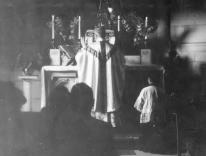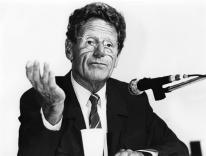Charles Camosy was in the audience when President Barack Obama called for “open hearts, open minds, and fair-minded words” in the abortion debate during his May 2009 commencement speech at Notre Dame. Camosy took the call seriously and began plans for a gathering that would allow both sides to practice what the president preached. Now a theology professor at Fordham, Camosy knew that he would need help. The eventual organizing committee included bioethicist Jennifer Miller along with two prochoice heavyweights: Princeton ethicist Peter Singer, who has famously defended the morality of infanticide under certain circumstances, and Frances Kissling, former president of Catholics for a Free Choice.* The efforts of all four came together last weekend, as nearly four hundred scholars, activists, and students gathered at Princeton for the conference.
It is nearly impossible to measure the impact of a conference, especially on an issue that has been subject to such a longstanding and entrenched social struggle. We may be able, however, to draw some tentative conclusions about the future direction of the abortion debate based on the tone and content of the conversations that occurred across the prochoice/prolife divide. Though these conversations did not end with the joining of hands and the singing of “Kumbaya,” they were valuable to the extent that they cleared the field of misperceptions and caricatures, sharpening the points of real disagreement. This was especially noteworthy on several topics that have been bitterly contested over the past four decades of legalized abortion:
The fetus: The conference highlight may have been the debate between natural-law theorist John Finnis, Singer, and Georgetown philosopher Maggie Little regarding the moral status of the fetus. Only Finnis would favor the legal prohibition of abortion, but all three view the fetus as a human being. Responding to an earlier comment by an audience member who explained that his views had become “more sophisticated” since the days when he picketed with an “Abortion Kills” sign, Singer was candid: “Your sign was correct.” Prolifers may (understandably) suspect that their opponents dismiss the unborn child as a mere clump of cells, but among these leading scholars, that position is indefensible. Of course the recognition of humanity can lead to starkly different conclusions—for Finnis, the embryo has the same moral status as the five-year-old because, given sufficient sustenance and time, it will become a mature human being, while for Singer, moral status is about our developed mental and physical capacities. Hence, for severely disabled infants, killing can still be a moral option. Little took a gradualist position, arguing that the moral status of the fetus develops as the pregnancy progresses. (By comparison, there was no discernible disagreement among conference participants regarding the moral status of women or society’s obligation to support pregnant women, though of course there was widespread disagreement on the authority a woman has over the life of her fetus.)
Fetal pain: Two physicians, one of whom is an abortion provider, debated the question of fetal pain and its ethical implications. Neither suggested that the ethical implications of fetal pain would be zero; the focus was on the scientific question of whether fetal pain is a reality, not on denying its relevance. This was one of several areas in which the debate centers on an empirical question, not just on moral assertions.
Conscience: From both the pro-life and pro-choice sides, there was consensus that individual health-care providers should not be forced to participate in abortion. Consensus broke down, however, regarding the right of institutions to decline to participate. Health-law expert Bernard Dickens said that “Catholic hospitals are a community resource,” and thus when community values clash with Catholic values, the community values must win out. Pro-life participants (including me) tried to point out the dangers of pushing Catholic institutions out of health care and how a robust defense of pluralism can be good for a society. At least on abortion, then, individual rights of conscience appear to be a shared value; institutional rights, though, are very much in dispute.
Selective abortions: One panel grappled with the question, “Do some reasons for abortion exacerbate discrimination against persons?” Speakers touched on gender-based abortions, but the focus quickly turned to abortions based on the prenatal diagnosis of disability. No one suggested that the motivations underlying these abortions are morally insignificant, though not everyone agreed that the moral significance should carry legal significance. Repeated exchanges between Eva Kittay and Lisa Schiltz, both scholars and mothers of children with disabilities, clarified the stakes: Schiltz argued that the high percentage of Down’s Syndrome diagnoses that result in abortion (greater than 90 percent) sends a powerful social message to people living with Down’s Syndrome that they are of lesser value, and she worries that the diminishing population of people living with Down’s Syndrome could undermine social support for them and their caregivers. Kittay, on the other hand, expressed skepticism that the highly personal nature of the decision could reasonably give rise to a broader social message of diminished value, and she is optimistic that greater social awareness of, and support for, people with disabilities will remain despite the fact that nine out of ten Down’s diagnoses result in abortion.
Roe v. Wade: The last session of the conference, on whether abortion should be a constitutional right, proved to be the greatest challenge for maintaining the open-minded and open-hearted atmosphere. It was the only session in which the audience temporarily fell back into the pep rally mode, applauding their favorite (and familiar) lines. This was hardly a surprise, as advocates view Roe v. Wade as either a mighty blow for justice, along the lines of Brown v. Board of Education (as legal historian David Garrow argued during an earlier session) or as “an overreaching ruling that not only misinterpreted the Constitution but also badly wounded our politics” (as constitutional law scholar Richard Garnett argued). What might have been surprising were the views of two noted supporters of legalized abortion (Singer and Georgetown law professor Robin West), who expressed their conviction that Roe has been bad for democracy and for the long-term prospects of legalized abortion. If we were able to ground the right to abortion in a political framework, their argument goes, it would be anchored more securely than its current precarious position on the (intensely contested) views of a five-justice Supreme Court majority. Singer went further, expressing sympathy for prolife advocates whose political arguments have been ruled out of bounds as a matter of constitutional interpretation. The anti-Roe sentiment is hardly universal on the prochoice side—Garrow, at this point seated in the audience, began loudly slapping his shoe in apparent protest of what was being said—but the conference made clear that Roe is not as sharp of a dividing line between prochoice and prolife camps as one might have suspected.
Aside from bringing the scope of substantive disagreement into greater clarity, the conference left two overarching impressions. First, while both the prolife and the prochoice camps view each other with a significant amount of fear, there’s far greater suspicion on the prochoice side. At one level, that is understandable. After all, the status quo essentially permits abortion on demand throughout pregnancy, provided the mother’s health (broadly construed) is at risk. If common ground between prochoice and prolife advocates is to be implemented legally, the move will likely be toward the prolife side of the ledger. Given that the status quo largely reflects the prochoice perspective, more than one prochoice participant expressed exasperation along the lines of “Why are we even here? What do we stand to gain?” Even one of the organizers (Kissling) expressed pessimism in her closing remarks, concluding that she does not discern much in the way of common ground between the two camps.
At another level, however, fear gives the appearance that the two sides are even farther apart than they are. One participant expressed concern that, “if Catholics win on the abortion issue, they’ll try to outlaw birth control too.” Another speaker explained that opposition to abortion and birth control are all part of the same agenda. As Helen Alvaré helpfully pointed out, given the low percentage of Catholics who support the church’s teaching on birth control, it is a stretch to insist that opposition to birth control is the driving force behind opposition to abortion.
Another source of fear is the specter of “religious arguments” being crammed down the throats of citizens who do not share the tenets of a particular faith tradition. While this concern may be justified on some issues, the prolife position is not a religious argument. On this question, the prolife voices found an unexpected ally in Singer, who unequivocally explained that natural-law arguments against abortion are not religious. Even though he finds them unpersuasive, Singer recognizes that they are arguments based on reason, accessible (if not always agreeable) to the religious and nonreligious alike. In other words, of all the good-faith arguments in support of abortion rights, fear of theocracy should not be one of them.
The second overarching impression left by the conference is that relationships matter, even in the abortion debate. With a few exceptions, the debates last weekend were civil and courteous; speakers appeared to be listening to each other, not just waiting for their opponent to stop talking; and questions from the audience were actual questions, not just arguments to which a question mark was attached. Whatever gains were made in our mutual understanding of substantive areas of disagreement, they were made, in significant part, because we were all involved in a face-to-face conversation. We were not writing op-eds, waving signs, or firing up the base in the run-up to another election, as important as those activities can be. We were encountering one another as human beings who stake out opposing positions on an issue of vital importance.
Perhaps the most poignant and powerful snapshot of the conference came at dinner, where organizers had deliberately arranged the seating to foster conversations across the divide. A Catholic theologian, who regularly prays the rosary with his children outside abortion clinics, found himself eating with an abortion doctor. He had never done so before, and he made the obvious, but heartfelt, observation, “I don’t think I have fangs. And I don’t think you do either.” It is naive to believe that a single gathering can resolve a conflict over the meaning of human life and the obligations that society has in light of that meaning. At the same time, it is unduly pessimistic to deny that a single gathering can be an important step down a very long road.
*The original version of this sentence, which erroneously identified Kissling as founder of Catholics for a Free Choice, has been corrected.
From dotCommonweal: Abortion & "Species Membership"
Read more of Commonweal's abortion coverage here.
Please email comments to [email protected] and join the conversation on our Facebook page.
Previous Story
Archbishop on 'lukewarm' Catholics
Next Story
Abortion and "species membership"


